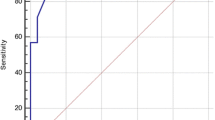Abstract
Comparative evaluation of arterial blood gas in patients with stridor, before and after emergency tracheostomy. The present prospective study was conducted in tertiary care Centre from February 2022 to June 2023 on 42 patients who presented with stridor and underwent emergency tracheostomy in our department. After proper history taking and clinical examination, nonsurgical cause of stridor was ruled out. Patients were then classified on the basis of location of cause of stridor (whether oropharyngeal, hypo-pharyngeal, supra-glottic, glottic or sub-glottic). Immediately an arterial blood gas (ABG) analysis was done, and emergency tracheostomy was performed. Following tracheostomy, ABG analysis was done immediately, after 12 h and after 24 h. The mean age of presentation of stridor in our study was 65.02 ± 3.23 years, with male preponderance (Male: female ratio being 3.66:1). Most common etiology of stridor in our study was glottic carcinoma comprising 50%, and least common etiology of stridor was hypopharyngeal carcinoma, and subglottic stenosis comprising 2.4% each. There was statistically significant normalization of ABG in terms of pH, PO2, PCO2, HCO3. Mean pH, PO2, PCO2, and HCO3 before tracheostomy were 7.31, 74.8, 60.6, and 29.8 respectively. Mean pH, PO2, PCO2, HCO3, immediately after tracheostomy were7.38, 91.3, 48.4, and 27.4 respectively. After 12 h of tracheostomy, mean pH, PO2, PCO2, HCO3 were 7.41, 95.4, 42.7, 25.3 respectively. Mean pH, PO2, PCO2, HCO3 24 h after emergency tracheostomy were 7.441, 95.5, 42.8, 24.6 respectively. Emergency tracheostomy in stridor patients improves the acid base and ventilatory status, by relieving the obstruction as evidenced by statistically significant improvement in arterial blood gas values, and can be used as a diagnostic tool in upper airway obstruction.
Similar content being viewed by others
Data Availability
Available with corresponding author upon reasonable request.
References
Selvam DK, Vikram VJ, Sakteeswaran M, Mohammed IMP (2017) A study on paediatric stridor causes and management: case series. Int J Otolaryngol Head Neck Surg 3(4):1031–1035. https://doi.org/10.18203/ijohns20174327
Patnaik S et al (2021) Etiology, clinical profile, evaluation, and management of stridor in children. Indian J Pediatr 88(11):11155–21120. https://doi.org/10.1007/s12098-021-03722-8
Hollinger LD et al (1980) Etiology of stridor in the neonate, infant and child. Ann Otol Rhino Laryngol 89(5 Pt 1):397–400. https://doi.org/10.1177/000348948008900502
Chourpiliadis C et al (2022) Physiology, respirator rate. Statpearls Publishing, Treasure Island (FL)
Castro D. et al. (2023) Arterial Blood Gas.In: statpearls[Internet] . Treasure island (FL): Statpearls Publishing. 30725564/NBK536919
Hohn A et al (2017) Awake tracheostomy in a patient with stridor and dyspnea caused by a sizeable malignant thyroid tumor: a case report and short review of the literature. Clin Case Rep 5(11):1891–1895. https://doi.org/10.1002/ccr3.1216
Leyn PD et al (2007) Tracheostomy: clinical review and guidelines. Eur J Cardiothorac Surg 32(3):412–421. https://doi.org/10.1016/j.ejcts.2007.05.018
Benson BE et al. (2022) Stridor clinical presentation. Medscape
Kamath MP et al (2010) Role of estimation of arterial blood gases in the management of stridor. Indian J Otolaryngol Head Neck Surg 62(2):125–130. https://doi.org/10.1007/s12070-010-0025-5
Crofis SL, Aieer A, McGuire GP, Wong DT, Charles D (1995) Can J Anaesth 42:775–799
Friedman Y, Fildes J, Mizock B, Samuel J, Patel S, Appavu S, Roberts R (1996) Comparison of percutaneous and surgical tracheostomies. Chest 110:480–485
Wagner PD et al (2015) The physiological basis of pulmonary gas exchange: implications for clinical interpretation of arterial blood gases. Eur Respir J 45(1):227–243. https://doi.org/10.1183/09031936.00039214
Davis K, Robert S et al (1999) Changes in respiratory mechanics after tracheostomy. Arch Surg 134(1):59–62. https://doi.org/10.1001/archsurg.134.1.59
Acknowledgements
None
Funding
Nil.
Author information
Authors and Affiliations
Contributions
AB made contribution in data collection and design of manuscript. MM, NG, PK made contribution in interpretation of data. SK made contribution in data analysis. All authors read and gave approval to the final version of submitted manuscript.
Corresponding author
Ethics declarations
Conflict of interest
The authors declare they have no competing interests.
Ethical Approval and Consent to Participate
The study was conducted after approval by Institutional Ethics Committee of GMC Jammu. Written informed consent was taken from all subjects or their legal guardian in case of age of patient being less than 18 years. No animals were used in the study.
Human or Animal Rights
The study was conducted on 42 human patients (no animal was used for research) and was issued by institutional ethical committee GMC. Jammu.
Consent for Publication
Written informed consent to publish patient’s clinical details was obtained from all subjects or their legal guardian in case of subject under 18 years.
Informed Consent
Written informed consent was taken from all the study patients in the language that patients/ attendants understood.
Additional information
Publisher's Note
Springer Nature remains neutral with regard to jurisdictional claims in published maps and institutional affiliations.
Rights and permissions
Springer Nature or its licensor (e.g. a society or other partner) holds exclusive rights to this article under a publishing agreement with the author(s) or other rightsholder(s); author self-archiving of the accepted manuscript version of this article is solely governed by the terms of such publishing agreement and applicable law.
About this article
Cite this article
Manhas, M., Bashir, A., Gupta, N. et al. Arterial Blood Gas Analysis in Patients with Stridor, and the Impact of Emergency Tracheostomy on It: A Tertiary Care Center Experience. Indian J Otolaryngol Head Neck Surg (2024). https://doi.org/10.1007/s12070-023-04456-z
Received:
Accepted:
Published:
DOI: https://doi.org/10.1007/s12070-023-04456-z




